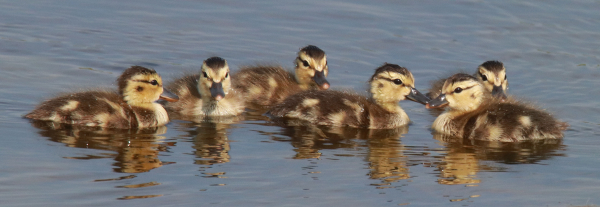New broods of ducks have been hatching every day since mid-June, but I only observed 5 different species of duck broods until July 6th, when the first Gadwall brood appeared less than 2 miles north of my office at Bobby’s Lake. It’s always exciting to see a new species of ducklings as summer progresses, and it was doubly exciting because this was a mega-brood of newly hatched ducklings – there were 19 downy little ducks with the Gadwall female! That’s the largest Gadwall brood I’ve ever seen, by far.

This photograph shows the female Gadwall with 18 of the 19 ducklings feeding peacefully on the water surface. One duckling was positioned a bit farther behind the others and was not included in this image to show the others at a little larger scale (600mm zoom lens, f-14 aperture, 1/640 shutter speed, 800 ISO).
Some species of ducks are prone to “dump nesting,” which is a term that describes when a female duck lays her eggs in another female duck’s nest, leaving her eggs for the first hen to incubate and raise the ducklings. Female Redheads are well-known for dump nesting, as are Canvasbacks, and to a lesser extent Blue-winged Teal, but I’m not aware of Gadwalls practicing this very often – at least I can’t remember ever seeing a “double brood,” and I live and work in Gadwall central.
One other thing that seemed unusual about this recently hatched brood was that the ducklings began diving in earnest. Gadwalls are not usually “diving ducks” – Redheads are, but Gadwalls feed on the surface of the water almost exclusively. And the ducklings made really spirited dives with the ducklings diving straight down with a plume of water flying above them as they disappeared from view below the water surface. However, during subsequent observations of this brood the ducklings foraged on the surface as expected, prompting me to wonder if the ducklings were bathing during the diving episode, rather than foraging.
Photographing the mega-brood of Gadwall ducklings was pretty straightforward: The sun was positioned directly behind me, with the ducks spread out broadside before me, and the time was 6:30pm – realistically when the best light was available. Those lighting ingredients ensured the truest colors, the least amount of shadow, while providing the best options for optimizing the aperture and shutter speed.
With 20 ducks in the photo frame counting the female, I wanted to be sure to get as many ducklings in focus as possible along with the female, so I really ramped up the aperture to f-14, which still left an ample shutter speed of 1/640. The resulting photo shows the entire brood in focus, which brings to mind that it’s best to focus on the closest bird to ensure it is in focus, and hopefully the sharp image extends to include most or all of the rest of the group.

This brood of 6 Blue-winged Teal shows that from a photographer’s standpoint, fewer ducklings in a photo frame means showing more detail in each of the birds, while emphasizing just how cute downy ducklings really are, especially when there is a group of them (600mm zoom lens, f-9 aperture, 1/1250 shutter speed, 800 ISO).
While the mega-brood photo is more of a documentary photograph, so you can count the number of ducklings as they forage, I also wanted to share how thrilling it is to have the chance to take a close-focus photo of a duck brood. Therefore the second photograph shows a brood of recently hatched Blue-winged Teal ducklings that really shows the details of the little ones and illustrates how cute downy ducklings truly are – now imagine 19 of them together!
Article and Photographs by Paul Konrad
Share your bird photos and birding experiences at editorstbw2@gmail.com